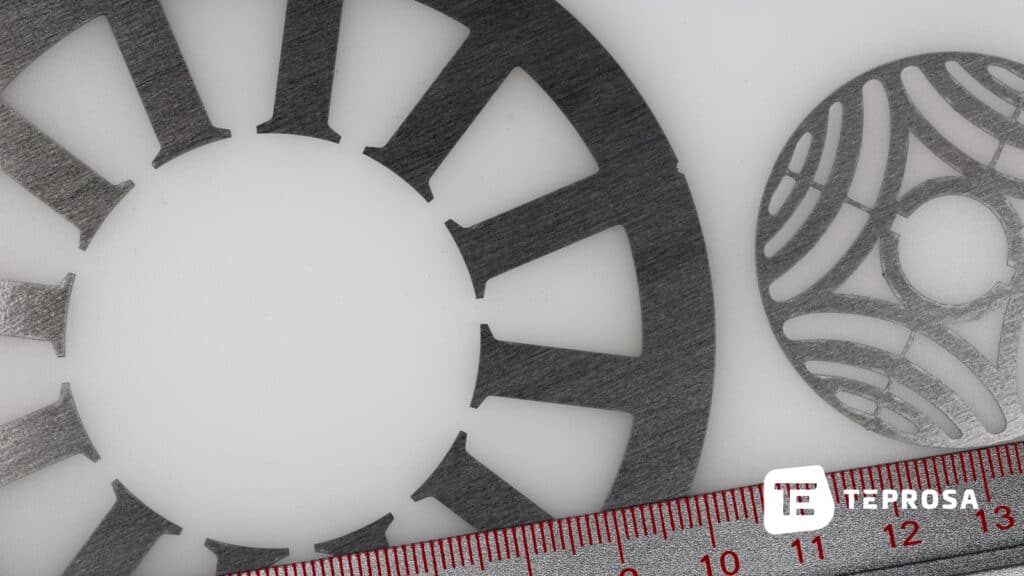Electrical sheet or electrical strip is an iron-silicon alloy and the steel material of choice for the production of magnetic cores as rotors or stators in electrical machines. Due to its special properties, the use of laminations made of electrical steel sheet for the production of iron cores leads to a significantly improved energy efficiency of electrical systems and thus to a sustainable use of resources.
Different cold-rolled strips are divided into grain-oriented and non-grain-oriented materials according to their properties. TEPROSA manufactures laser-cut sheet lamellas as well as finished sheet packages for prototypes and small series.

Electric Sheet Metal Laminations Stator and Rotor Sheet TEPROSA Laser Cutting
Modern electric vehicles and other electric systems require advanced electric motors that are not only powerful but also economical in energy consumption.
One of the most important factors here is the use of magnetic materials, which transmit the magnetic field and thus also the electromagnetic force in the electric motor. The current generated in the battery creates the magnetic field in the stator of an electric motor. This interacts with the rotor and causes a rotational force that is transmitted to the wheels of the electric vehicle either directly or via a gearbox.
The electrical sheet, from which both the stator and the rotor are constructed, plays a key role in this energy transfer. The electrical sheet material is produced in a metallurgical process in the form of electrical steel strip in various grades. This electrical steel is stamped into electrical steel lamellae or cut by laser.
Using various technologies (e.g. welding, riveting, bonding (baked enamel technology)), magnetic cores, i.e. stators and rotors, are manufactured from the electrical steel laminations. The grade of electrical steel used defines the subsequent behavior of the electric motor. Optimum selection of the electrical steel grade guarantees the best possible combination of performance, efficiency, economy and service life of the electric motor.
At TEPROSA, the electrical steel laminations are laser cut and layered into magnetic cores using gentle joining methods.
These magnetic cores are then fitted by electric motor manufacturers with magnetization windings made of copper wire and with permanent magnets. Finally, these are impregnated, installed in the motor housing and from now on they can take over the function in the drive of an electric vehicle or other electric system.
Electrical sheet is made of iron-silicon alloy and is divided into grain-oriented and non-grain-oriented materials. The starting material is manufactured as cold-rolled strip. It has special physical properties and belongs to the soft magnetic materials. Here is an overview of the standard grades for use in electrical systems that we process at TEPROSA:
In order to prevent the short circuits between the lamellae in electrical sheet packs and thereby reduce the eddy currents, various coatings are applied to the strip. The coatings vary in thickness from 1 to 4 µm. Depending on the processing technology and subsequent application, coatings exist for better corrosion protection, improved insulation of the individual layers, heat resistance, improved punching properties or weldability.
The electrical steel or the electrical sheet made from it is basically classified into two types: as isotropic or non-grain oriented and as anisotropic or grain oriented electrical steel.
As the name implies, the magnetic properties of isotropic electrical steel are largely uniform and therefore almost independent of the direction of magnetization. This isotropy arises due to a non-ordered distribution of the position of iron elementary cells in the electrical steel.
Homogeneity of magnetic properties is important for all rotating machines, such as electric motors or generators. Minor inhomogeneities (anisotropies), which are unavoidable in the manufacturing process of electrical steel, can be compensated by using special technologies in the construction of electrical machines.
In contrast to isotropic or non-grain-oriented electrical steel, anisotropic or grain-oriented electrical steel exhibits excellent magnetic properties in one direction only. In a complex metallurgical process, the iron elementary cells are aligned to achieve a uniform orientation (texture). These properties are optimal for transformers, where the individual legs can each be manufactured in the most magnetically favorable direction. Grain-oriented electrical steel is therefore mainly used for the manufacture of power and distribution transformers.
The surface of particularly low-loss grades of grain-oriented electrical steel is treated with laser. This process, known as “laser scribing”, leads to the refinement of magnetic domains and thus to the improvement of the magnetization process.
When laser scribing from the non-grain-oriented electrical steel, care must be taken to minimize the heat-affected zone and the associated degradation of magnetic properties.
When laser cutting from grain-oriented electrical steel, it must also be prevented that microscopic metal splashes or slag remain on the sheet surface. This could lead to damage of the insulating coating and increase of eddy current losses.

TEPROSA GmbH, Paul-Ecke-Strasse 6, 39114 Magdeburg, Germany
Geschäftsführer & Gesellschafter der TEPROSA GmbH.